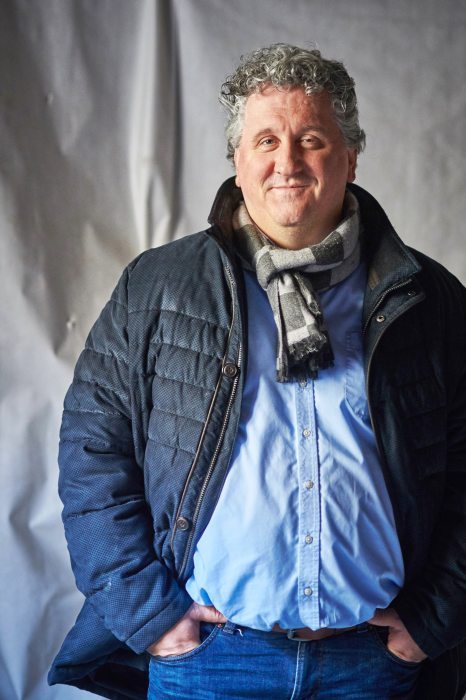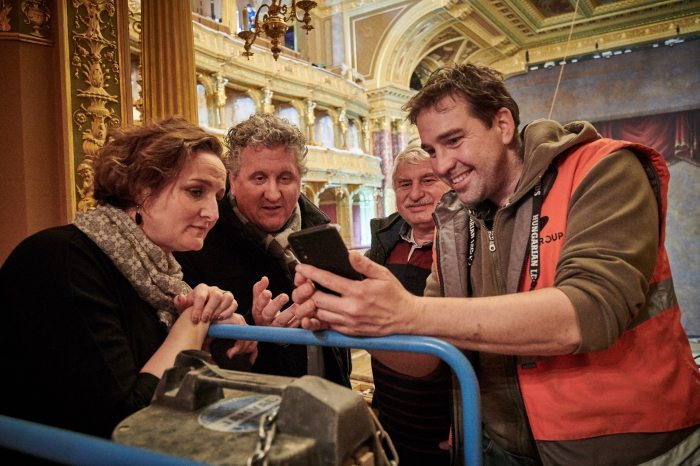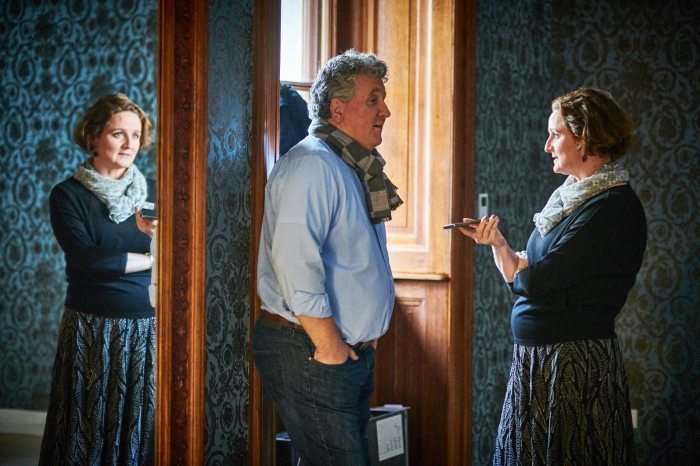The Opera House opens – We talked to Szilveszter Ókovács, General Director
The stage of the Hungarian State Opera House, including the rigging loft, is said to be as many cubic meters as the entire Víg theatre, which means that, with a little exaggeration, Víg - with the parts that overhang here and there cut off - could fit on the stage of the Ybl Palace. I don't know if that's true, but it's certainly a dizzying sight from the rigging loft, depth and height, a network of steel wires calculated with engineering precision, and construction workers bustling below and on the balconies around. When we were there, work was still in full swing in every part of the Opera House, which has been closed for almost five years, with a month to go before it is due to be reopened (our report was written in February - editor's note), and rehearsals were already underway for the various performances of the reopening, which will last several days.

Szilveszter Ókovács, General Director of OPERA, must be optimistic: according to the contract, the contractor's staff will leave on the tenth, and on the 11th there will be a press conference and a dress rehearsal. For the moment, however, there is no corner to sit down for interviews, and in fact, wherever we go, we are in the way. The General Director is a guide, showing us the way around power lines, ladders, and grinding machines. The Opera House is a wonderful setting for this performance also, and the skilled workers working on the various details are also extremely proud to be working on this particularly beautiful task.
We spend a little time in the Red Salon, where the new upholstery - red, of course - is being tailored. Two paintings will soon be arriving from the National Gallery, László Hunyadi's Lament by Viktor Madarász and László Hunyadi's Farewell by Gyula Benczúr. Ferenc Erkel, the Opera House's first music director, had an excerpt of his opera Hunyadi László performed at the original opening in 1884, and now, for the reopening, the entire work will be staged in a new production, this time directed by Ókovács - and the renovation director László Baán has lent the large-scale paintings on the same theme from the gallery he runs.
For us, Hunyadi is perhaps the most emblematic Hungarian opera, but the only piece that is staged around the world, and is much better known, is Bluebeard's Castle, which became popular and well-known as a result of the joint work of Béla Bartók, Béla Balázs and Miklós Bánffy. The original plan was to open the renovated Opera House on the centenary of the work's birth, but this was not to be.
"The renovation was necessary, so we have been preparing for it ever since I have been running this institution," begins the General Director. "Of course, the theatre was working, but the stage machinery was on its last legs. Everybody thought it was beautiful, and it was indeed beautiful, but you have to know that a lot depends on the functioning of the machinery that serves the great performances of the Opera House. An opera house with a real repertory also has a large auditorium because of the ticket prices, and a large stage to go with it. The huge space means that the stage has to move a large chorus, 80-90 people, who have to be seen and heard from all sides, and this requires a platform system, which in turn means that the sets are also huge and those have to be moved and packed, too. The functioning or non-functioning of this complex system of lifts and platforms is a major problem. It's like fumbling with the main switch: you have to make a decision until it's completely decayed. There have been occasions when a 'street' or a swivel - part of the stage machinery - has stopped during a performance and the play could not run to its full potential. In order to start the renovation of the Opera House, the Erkel Theatre, which was closed at that time, first had to be temporarily repaired so that the company could perform there during the renovation.
It took a year and a half to fight for the Erkel Theatre, then twice as long to get it off the ground - it's not automatic that opera-loving audiences will come over. The Erkel is like a whole other world - but also a different part of town.
From 2015, we had plans for what we were going to do with the Opera House, but we also knew that we could only start in 2017 because of public procurement and pre-planning, which is why I usually refer to it as programmed shutdown. The 'package' also included the Eiffel Workshop, which was to be converted from the Northern Vehicle Repair Workshop and was due to be completed in 2017. So it's a ten-year plan, with an outlay of almost 100 billion, in a time of a big construction boom, with a complicated chain of procedures - anyone who has been involved in something like this knows that it cannot be done flawlessly, without breaking the quality-time-price triad.
Wall research and a kind of economic approach overrode the plans, and the government finally decided to close it and completely renovate it, which was understandable, but for us, the company, it was a long and difficult period. We were stuck in the Erkel Theatre for longer than previously expected, and then Covid hit, while our rental properties became too many and our income dried up. But that has passed, and we have made up for it with success, and now we have to put all that behind us and look forward. We can look forward to the new building, which is much more modern than the old one, where we do not have to worry about a wire catching fire in the wall because it was designed for a much smaller capacity. Top or bottom stage machinery is now world-class, sure to last 30 years. Since the renovation was carried out along the main lines of the original plans by Miklós Ybl, there will be a little less space for spectators - the auditorium was enlarged in 1912 at the expense of the orchestra pit - but they will be more comfortable and the acoustics will be better."
Ybl originally won the design competition for the Opera House, and Gábor Zoboki, the lead architect of the current renovation, is following in his footsteps. Zoboki is also known to be a great opera fan, especially fond of Wagner, and with a kind of holy devotion, he wants to get the best out of the Opera House. But this takes time, and the company has long wanted to take possession of the building, which is creating tension between the builders and the future operators. But this period is coming to an end, with the opening fast approaching and the renovation has brought many unexpected adventures for all. In the projection zone above the Royal Box, for example, a kind of time capsule was found, almost a cubic meter of letters, documents, and notes from the turn of the century stuffed there, presumably to be hidden from the communists by the Opera House staff in 1948.
We hope that after careful archival research, the general public will also be able to get to know this unique material, the letters to the Intendant of the Opera House, beginning with "Your Excellency the Count!", and other cultural and historical delicacies.
What can we expect after the reopening, I ask Szilveszter Ókovács. "We have to acknowledge that these pandemic times do no good to the theatres or the opera. We have to work very hard to at least keep the operation up. We have to fight for every audience again, which was not the case before. But those who come to us will see a big spectacle on a big stage, as befits an opera house. If we can continue to run the Erkel, which we are happy to do, we will create an inclusive theatre there. Of course, we can move more popular plays, such as the Gypsy Baron or Háry János, but we will definitely perform the classical, grand operas and ballets on the Opera House stage. And for those who like contemporary, experimental, modern dance, these pieces will have a great place in the Eiffel, which the public has very quickly come to love. This kind of two- or three-legged operation can take us to the world-class and keep us there infrastructurally, and artistically we can commit to being at the forefront of Europe because, in terms of resources, it is realistic."
It's hard to believe, but on 10 March the contractors will leave the site, and the opening ceremony will start with a press conference on the morning of 11 March, at the Opera House. On that Friday, a small exhibition of Hunyadi paintings will be opened, a crowd of students from both Hungary and from across the border will watch the dress rehearsal of Hunyadi in the early afternoon, and in the evening, construction workers, children from the "Regőczy" and many others will enjoy the main rehearsal of next day’s the gala concert in the same place.
The 12th will be the dress rehearsal of Mayerling, a neoclassical ballet that tells the tragic story of Crown Prince Rudolf and Archduchess Sofia. In the evening, there will be the grand opening and gala concert, when President János Áder will open the Opera House to the public as one of his last official duties. A fantastic Hungarian program is being prepared, including Dohnányi's Festival Overture, which the General Director described as "pleasantly megalomaniac", as the composer wrote it for two full symphony orchestras and a brass orchestra, to mark the 50th anniversary of the unification of Pest and Buda. "All these musicians on stage make for an amazing experience. The music will literally hit the audience," promises Ókovács. But Placido Domingo will also conduct Hungarian-related pieces, and a Háry János section will also be staged, so the ballet choir, the chorus, and even children will be able to try out the stage they will finally be able to take over. The next day will see the premiere of Ferenc Erkel's opera Hunyadi László, followed by Mayerling on the third day, and Hunyadi again on the 15th, the national holiday. Since the renovation work is still in progress, these rehearsals are taking place in the Eiffel, where five rehearsal rooms are being built to ensure a smooth workflow. All this shows that life is still a struggle for the Opera House staff, who are all looking forward to the completion of the works as well as the coming of quiet weekdays.
Ókovács is also looking forward to these times, not taking his eyes off the flickering light at the end of the tunnel. "This is also where the Ybl Awards will be presented in March, and it is planned that the prestigious architectural prizes will always be awarded here, in this iconic building of the architect's life's work. To mark the occasion, we will give a festive concert of works by Ybl's contemporaries. For Easter, we'll be presenting a new performance of Parsifal, and in June we'll finally complete the Ring, Wagner's cycle of four operas. We've already performed three of these before the renovation, so it's the highest time to complete the series. Sooner or later, we'll finally be able to play everywhere, and we'll be able to play at full steam on newly renovated stages in beautiful theatres. And we really hope that audiences will soon find their way back - to eat home-cooked food and gourmet delicacies instead of TV/net cans."
Képmás magazine is launching a new series called Public Treasure, in which Kata Molnár-Bánffy, the publisher of Képmás, talks to dedicated people whose successful work can be of interest to many, and is a Public Treasure, as the title of the series suggests: a common issue, something we want to take care of.











